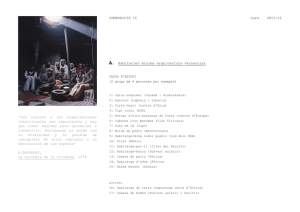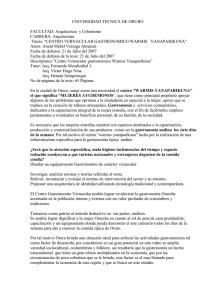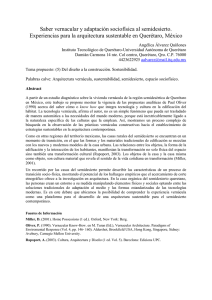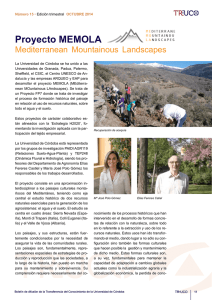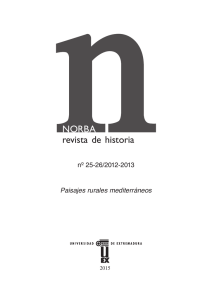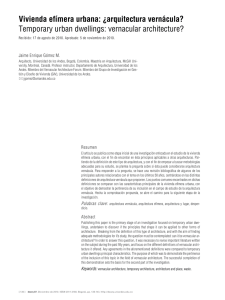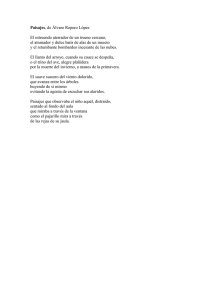Cultural Landscapes of Vernacular Architecture in Extreme
Anuncio
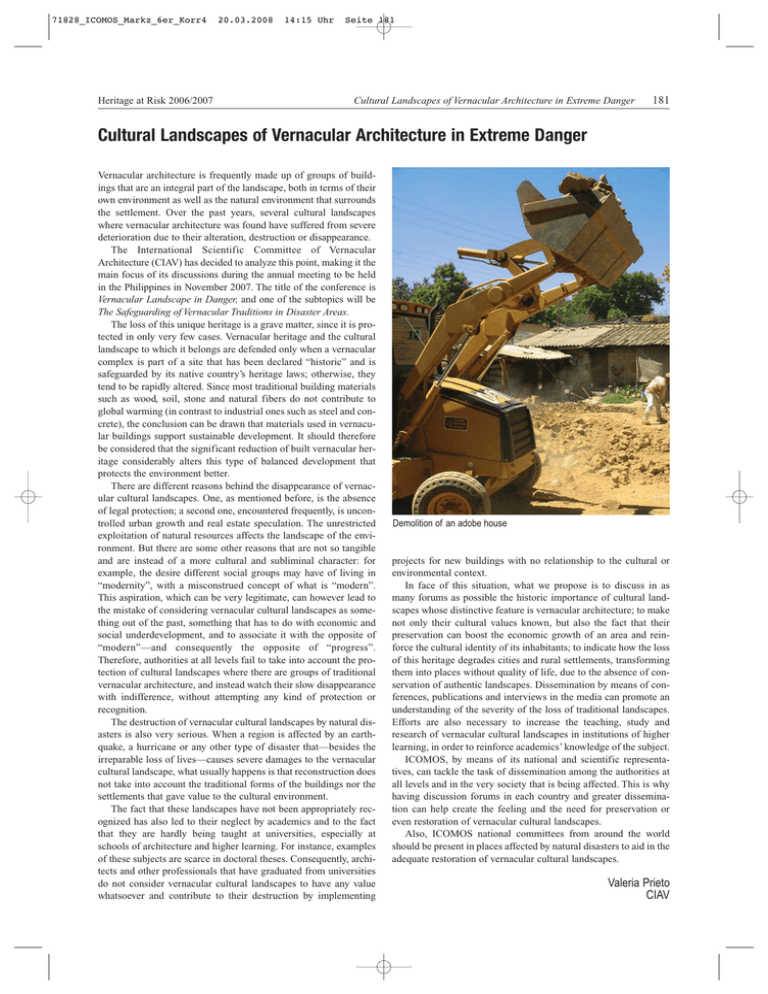
71828_ICOMOS_Markz_6er_Korr4 Heritage at Risk 2006/2007 20.03.2008 14:15 Uhr Seite 181 Cultural Landscapes of Vernacular Architecture in Extreme Danger 181 Cultural Landscapes of Vernacular Architecture in Extreme Danger Vernacular architecture is frequently made up of groups of buildings that are an integral part of the landscape, both in terms of their own environment as well as the natural environment that surrounds the settlement. Over the past years, several cultural landscapes where vernacular architecture was found have suffered from severe deterioration due to their alteration, destruction or disappearance. The International Scientific Committee of Vernacular Architecture (CIAV) has decided to analyze this point, making it the main focus of its discussions during the annual meeting to be held in the Philippines in November 2007. The title of the conference is Vernacular Landscape in Danger, and one of the subtopics will be The Safeguarding of Vernacular Traditions in Disaster Areas. The loss of this unique heritage is a grave matter, since it is protected in only very few cases. Vernacular heritage and the cultural landscape to which it belongs are defended only when a vernacular complex is part of a site that has been declared “historic” and is safeguarded by its native country’s heritage laws; otherwise, they tend to be rapidly altered. Since most traditional building materials such as wood, soil, stone and natural fibers do not contribute to global warming (in contrast to industrial ones such as steel and concrete), the conclusion can be drawn that materials used in vernacular buildings support sustainable development. It should therefore be considered that the significant reduction of built vernacular heritage considerably alters this type of balanced development that protects the environment better. There are different reasons behind the disappearance of vernacular cultural landscapes. One, as mentioned before, is the absence of legal protection; a second one, encountered frequently, is uncontrolled urban growth and real estate speculation. The unrestricted exploitation of natural resources affects the landscape of the environment. But there are some other reasons that are not so tangible and are instead of a more cultural and subliminal character: for example, the desire different social groups may have of living in “modernity”, with a misconstrued concept of what is “modern”. This aspiration, which can be very legitimate, can however lead to the mistake of considering vernacular cultural landscapes as something out of the past, something that has to do with economic and social underdevelopment, and to associate it with the opposite of “modern”—and consequently the opposite of “progress”. Therefore, authorities at all levels fail to take into account the protection of cultural landscapes where there are groups of traditional vernacular architecture, and instead watch their slow disappearance with indifference, without attempting any kind of protection or recognition. The destruction of vernacular cultural landscapes by natural disasters is also very serious. When a region is affected by an earthquake, a hurricane or any other type of disaster that—besides the irreparable loss of lives—causes severe damages to the vernacular cultural landscape, what usually happens is that reconstruction does not take into account the traditional forms of the buildings nor the settlements that gave value to the cultural environment. The fact that these landscapes have not been appropriately recognized has also led to their neglect by academics and to the fact that they are hardly being taught at universities, especially at schools of architecture and higher learning. For instance, examples of these subjects are scarce in doctoral theses. Consequently, architects and other professionals that have graduated from universities do not consider vernacular cultural landscapes to have any value whatsoever and contribute to their destruction by implementing Demolition of an adobe house projects for new buildings with no relationship to the cultural or environmental context. In face of this situation, what we propose is to discuss in as many forums as possible the historic importance of cultural landscapes whose distinctive feature is vernacular architecture; to make not only their cultural values known, but also the fact that their preservation can boost the economic growth of an area and reinforce the cultural identity of its inhabitants; to indicate how the loss of this heritage degrades cities and rural settlements, transforming them into places without quality of life, due to the absence of conservation of authentic landscapes. Dissemination by means of conferences, publications and interviews in the media can promote an understanding of the severity of the loss of traditional landscapes. Efforts are also necessary to increase the teaching, study and research of vernacular cultural landscapes in institutions of higher learning, in order to reinforce academics’ knowledge of the subject. ICOMOS, by means of its national and scientific representatives, can tackle the task of dissemination among the authorities at all levels and in the very society that is being affected. This is why having discussion forums in each country and greater dissemination can help create the feeling and the need for preservation or even restoration of vernacular cultural landscapes. Also, ICOMOS national committees from around the world should be present in places affected by natural disasters to aid in the adequate restoration of vernacular cultural landscapes. Valeria Prieto CIAV 71828_ICOMOS_Markz_6er_Korr4 182 20.03.2008 14:15 Uhr Seite 182 Paisajes Culturales de Arquitectura Vernácula en Riesgo Extremo Heritage at Risk 2006/2007 Paisajes Culturales de Arquitectura Vernácula en Riesgo Extremo Adobe house with thatched roof La arquitectura vernácula constituye en numerosas ocasiones conjuntos edificados que forman parte integral del paisaje, tanto de su propio entorno como del medio natural que rodea al asentamiento. En los últimos años numerosos paisajes culturales en los cuales se ha insertado la arquitectura vernácula han sufrido un serio deterioro debido a su alteración, destrucción o desaparición. El CIAV (International Scientific Committee of Vernacular Architecture), ha decidido analizar este tema que será el punto principal de sus discusiones durante su reunión anual que se llevará a cabo en el mes de noviembre en Filipinas. El tema de la conferencia es: “Paisajes vernáculos en peligro” (Vernacular Landscape in Danger). Uno de los subtemas será: “La protección de las tradiciones vernáculas en zonas de desastre” (The safeguard of vernacular traditions in disaster areas). La pérdida de este singular patrimonio es muy grave pues en muy pocos casos se encuentra protegido. Sólo cuando un conjunto vernáculo forma parte de un sitio que ha sido declarado como histórico y está salvaguardado por la ley patrimonial del país de que se trate, se defenderá el patrimonio vernáculo y el paisaje cultural al que pertenece, pero de no ser así tiende a verse alterado rápidamente. En virtud de que los materiales de construcción tradicionales tales como la madera, la tierra, la piedra y las fibras naturales no contribuyen al calentamiento global como ocurre con los de tipo industrial, por ejemplo el acero y el concreto, se puede concluir que los materiales empleados en las construcciones vernáculas apoyan el desarrollo sustentable. Por ello debe tenerse en cuenta que la disminución significativa del patrimonio vernáculo edificado altera significativamente este tipo de desarrollo equilibrado que protege mejor al medio ambiente. Las causas de la desaparición de los paisajes culturales vernáculos son diversas. Una, como lo hemos señalado es la falta de protección jurídica, otra que a menudo se presenta es el crecimiento urbano y la especulación inmobiliaria incontrolados. La explotación irrestricta de los recursos naturales afecta el paisaje del entorno ambiental. Pero hay algunas otras razones, más de carácter cultural y subliminal que tangibles: por ejemplo el deseo de los diversos grupos sociales de vivir en la “modernidad”, cuando moderno es un concepto mal entendido. Esta aspiración que puede ser muy legítima, lleva cometer el error de considerar al paisaje cultural vernáculo como perteneciente al pasado, al retraso económico y social, a vincularlo con lo opuesto a lo moderno y por lo tanto al progreso. Por ello autoridades de todos los niveles omiten la protección de los paisajes culturales en los que se insertan grupos de arquitectura tradicional vernácula y simplemente ven con indiferencia su desaparición paulatina, sin intentar algún tipo de protección y de reconocimiento. Es también muy seria la destrucción de los paisajes culturales vernáculos que se ven afectados por desastres naturales. Cuando una región es azotada por un sismo, huracán o cualquier otro tipo de desastre que además de cobrar vidas cuya pérdida es irreparable, causa graves daños al paisaje cultural vernáculo, lo común es que la reconstrucción no considere la forma tradicional de las construcciones ni los asentamientos que le daban valor al entorno cultural. El hecho de que estos paisajes no se hayan reconocido oportunamente también llevó al olvido su estudio por parte de las académicos y de su enseñanza en las universidades, muy especialmente en las escuelas de arquitectura y de educación superior. Son muy escasos los ejemplos de estos temas en las tesis de doctorado, por ejemplo. Por lo tanto los arquitectos y otros profesionales egresados de las universidades no les consideran valor alguno y contribuyen a su destrucción al realizar proyectos de nuevas edificaciones sin relación alguna con el contexto ambiental ni cultural. Ante esta situación lo que proponemos es difundir en todos los foros posibles la importancia histórica de los paisajes culturales cuyo rasgo distintivo sea la arquitectura vernácula. Dar a conocer no solo sus valores culturales sino el hecho de que su preservación puede impulsar el crecimiento económico de un sitio y reforzar la identidad cultural de sus habitantes. Señalar cómo la pérdida de este patrimonio degrada las ciudades y los poblados rurales, convirtiéndoles en sitios carentes de calidad de vida, en virtud de la falta de conservación de un paisaje auténtico. Solo la divulgación por medio de conferencias, publicaciones y entrevistas en los medios, puede ayudar a comprender la gravedad de la pérdida de los paisajes tradicionales. Es necesario también hacer esfuerzos por impulsar la enseñanza, estudio e investigación de los paisajes culturales vernáculos en las escuelas de educación superior, para reforzar el conocimiento de los académicos sobre le tema. El ICOMOS por medio de sus representaciones nacionales y científicas puede llevar a cabo la tarea de la difusión ante autoridades de todos los niveles y ante la misma sociedad afectada. Por ello la realización de foros de discusión en cada país a los que se les brinde la mayor difusión podrá ayudar a crear el sentimiento y la necesidad de la preservación o de la restitución, en su caso, de los paisajes culturales vernáculos. Asimismo las representaciones diversas de ICOMOS en el mundo deben estar presentes en los sitos afectados por desastres naturales para auxiliar en una adecuada restitución del paisaje cultural vernáculo. Valeria Prieto CIAV
